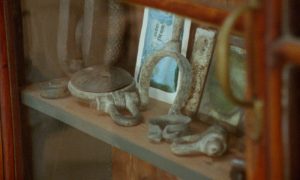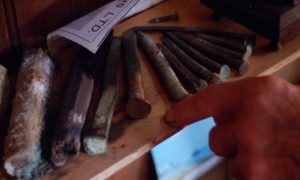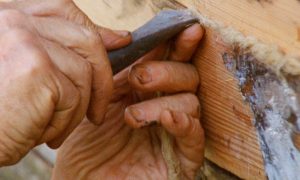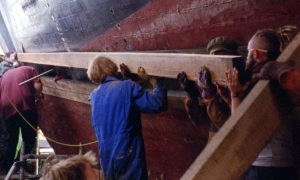Materials
Greg Powlesland is an artist and expert boat restorer who lives on the Helford River in Cornwall. Over the years, he has collected rare maritime items and materials. Most of these materials are natural rather than man-made and this chapter explores his collection. Starting with him sketching the Looe lugger Guide Me as she sails down river, we see Greg in connection with his environment, both natural and ecological.
Blocks

A block, in nautical terms, is a pulley consisting of a sheave (a wheel) or number of sheaves enclosed by wooden cheeks. In use, a block is fixed to the end of a line (a rope), a spar, or other surface, and a line is reeved through the sheave(s). A line that is reeved through the sheaves on a number of blocks makes a tackle, which gives the line purchase (mechanical advantage). On traditional and modern boats alike, blocks are crucial components of the rigging.
Boat Nails

Bronze nails were, and often still are, used as fastenings in traditional boatbuilding and shipbuilding. Bronze is corrosion-resistant compared to iron or steel, which is an important factor when considering the saline environment of a seafaring vessel.
Treenails (or trenail, trennel or trunnel)

Treenails are fastenings made from wood, hence the name, and they look simply like a wooden peg. They were used in traditional boatbuilding and shipbuilding and had numerous advantages over iron nails or bolts; wood expands when wet, meaning the treenail would grip well to the wood it was used to fasten. There was less chance of rot associated with other fastenings, and the treenails could be easily cut out and replaced if necessary. Over time, treenails were used alongside metal fastenings to reduce cost while maintaining strength.
Natural Fibre Rope

Traditionally, rope was made from natural fibres including jute, cotton, sisal, manila and hemp. Hemp was the strongest and most durable of these natural fibres and was used for ships’ weight-bearing lines. The fibres were spun into yarns, which were then twisted into strands. Three or more strands were then twisted again to lay the rope. Ropemaking would have taken place on a long rope walk with machinery and a ropemaker. Natural fibre rope is often more stiff than modern plastic varieties and is harder to splice (forming a joint between two ropes, or two parts of the same rope). In the film, Greg talks about ‘opening the lay’ and using a ‘fid’ to splice the rope. A fid is a conical pin or spike that can be inserted between two strands of the rope to make space to feed another strand in, which is part of the process of splicing.
Caulking

Traditional caulking is the process by which fibres are inserted between the planks of a hull or deck to make a wooden boat or ship watertight. These fibres are usually made of cotton or oakum (hemp soaked in pine tar). The spaces between planks are called seams and are made to be wedge-shaped. The caulking is then driven into these seams, using both a chisel-like tool called a caulking iron and a caulking mallet. There are specific methods by which the caulking is inserted to ensure the best coverage and durability. On the hull of a boat, the caulking is then covered over with putty. On deck, the seams are filled using melted pine pitch, which hardens once cool: a process called paying. Caulking allows the boat to flex as she sails whilst maintaining, more-or-less, a watertight hull.
Winter Refit
In this chapter, we see the Dutch brigantine Tres Hombres during her annual winter refit. The crew are replacing some of the planks on her hull, as well as parts of her rigging.
Steam Bending

We see the Tres Hombres crew take a large piece of wood out of a steam box and clamp it in place onto the hull of the ship. The purpose of steaming the wood before fitting is to make it flexible, so that it curves to the shape of the hull. The heat and moisture from the steam softens the fibres that make the wood pliable, which then hold their new shape when cool. The amount of time the wood steams for depends on the type of wood and how large it is. In the footage, the crew clamp the new plank into place, allowing it to cool in the correct position. We also see the crew preparing the planks either side with hand and machine planes before fitting the new one. Steam bending is a traditional process, once paramount in the construction of wooden vessels; it is a low energy method of manipulating wood, does not use toxic glues and creates less waste than other methods.
Splicing and Seizing

The Tres Hombres crew replace some of their running rigging, which refers to the lines on a boat that are used for the setting or handling of sails, spars or cargo. We see one of the crew splicing three-strand rope around an eye attached to a block, whereby the line is wrapped around the eye and then joined back to itself through a process of interweaving the strands of the rope. Splices are preferred to knots to join lines together because they are capable of retaining the rope’s full strength. Splicing is a traditional skill, but is often done on modern ropes too, albeit by a very different process.
The other crew member is seizing a rope becket or strop around a block. The rope is used to hold the block in the rigging, performing the function of the metal eye in the example above. Seizing is a process by which two lines are joined using smaller line, such as tarred marlin (hemp), that is bound around the two lines very tightly. The rigger uses a seizing mallet to gain purchase on the smaller line, by wrapping the line around the mallet and using the handle to lever the line as tight as possible. The crackling, creaking sound you hear in the footage is that of the marlin becoming very tight. The seizing is finished by wrapping the marlin between the two lines and making a series of half-hitches (knots). Seizings are then covered in a ‘blacking’ mix, made up of pine tar and linseed oil, which is painted onto the marlin to help preserve it.
Sailmaking

Steve Hall is a sailmaker who works from his traditional sail loft in Tollesbury, Essex. Steve specialises in traditional sails, serving many of the Thames sailing barges and Essex fishing smacks and bawleys in the area, along with other traditional boats of all kinds.
Handwork
In this chapter, Steve finishes the machining work on this new sail, and moves on to handwork. He starts by making rope grommets, which involve unlaying one strand of a rope, and relaying it onto itself to form an eye. The grommets are placed onto the liners to check for size and then a cutter is chosen to make the hole in the sail. The grommet is sewn by hand around the hole, to create a strong and hardwearing eyelet in the sail where it can be attached to running rigging or spars.
Scrub Down

Blue Mermaid is a 90-foot Thames sailing barge that does not have an engine. She provides residential trips for young people and vulnerable adults. Several times during the sailing season Blue Mermaid goes to Pin Mill on the River Orwell in Suffolk, where she floats onto ‘the blocks’ at highwater. When the tide goes out, Blue Mermaid sits on the blocks while her crew ‘scrub down’ the hull, cleaning it of the marine growth and barnacles that attach themselves over time. Once scrubbed, a new coat of antifouling paint is applied, which keeps marine growth to a minimum. The barge is then ready to sail again.
Scrubbing down is an important part of Blue Mermaid’s working life. It is unusual for a boat to clean their hull several times a season, but, for an engineless craft, keeping a clean hull can make all the difference. Improving the flow of water across the hull’s surface can make the boat more responsive and predictable, as well as faster.
A Thames sailing barge hull is completely flat on the bottom, making it easy for her to sit on blocks and for her crew to get underneath. The barge has leeboards either side of the hull which are lowered and raised as is necessary, and act as a keel, giving resistance through the water and preventing the boat sagging too much to leeward (sliding sideways through the water, away from the wind) as she sails.
Oarmaking

Lucy Harris is a boatbuilder who lives and works at Harry King’s Boatyard in Suffolk. In this chapter we see her making a sculling oar for her traditional engineless bawley (a type of fishing vessel) Helen & Violet.
Lucy talks about how there are no set rules for making an oar, nor designs to work from. They are made by feel and sight; if it feels and looks good, then it will probably work okay! To make a square piece of wood round, for the shaft, the boatbuilder undertakes a process of ‘siding’ whereby they progressively add more sides to the wood by taking each corner off (four sides taken to eight, then sixteen, etc) before rounding off the corners. Lucy is here using both a machine plane and a hand plane to prepare the wood before siding.
Sculling Oar
A sculling oar is used over the stern of a boat to scull, or propel, the boat forwards. The person using the sculling oar makes side-to-side motions with it in a figure of eight or similar, which creates a forward thrust in the water. In the film Wind, Tide & Oar, we see the skipper of the Looe lugger Guide Me sculling the boat out of harbour.
All images courtesy Huw Wahl